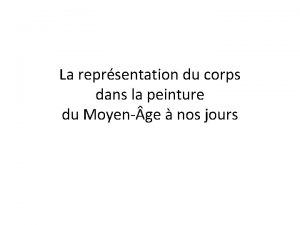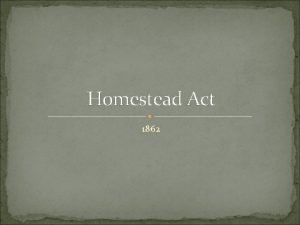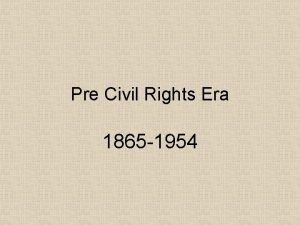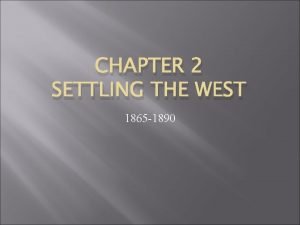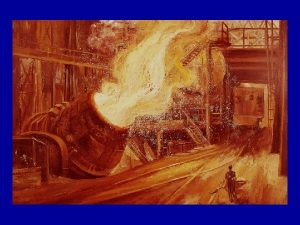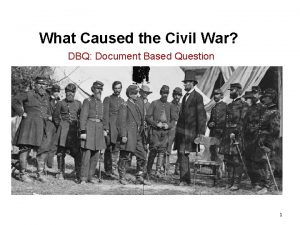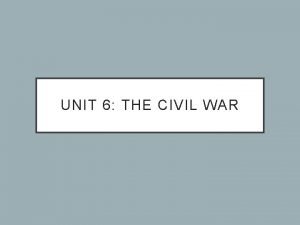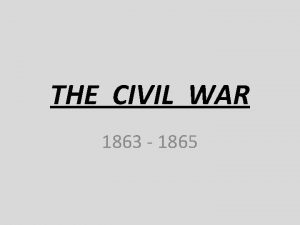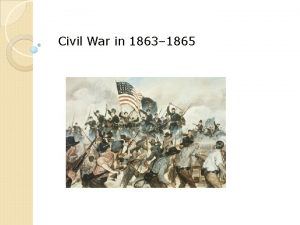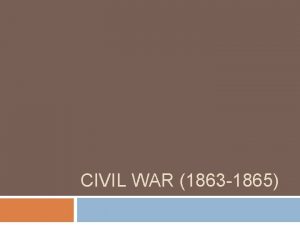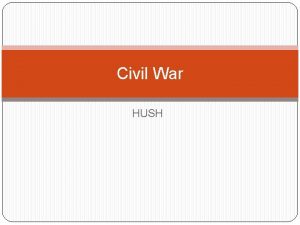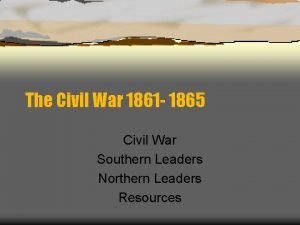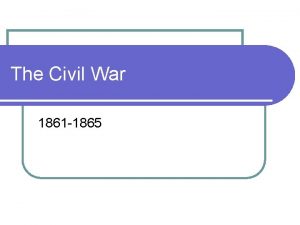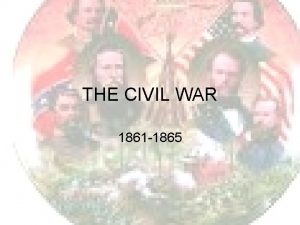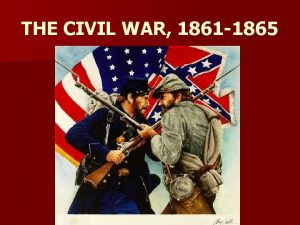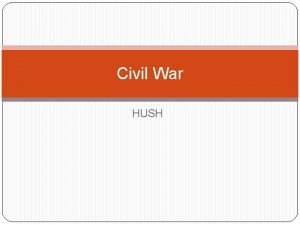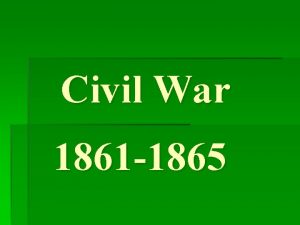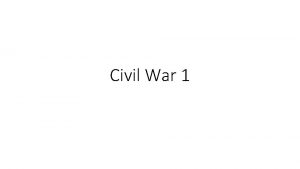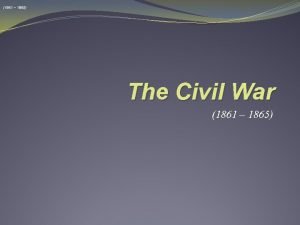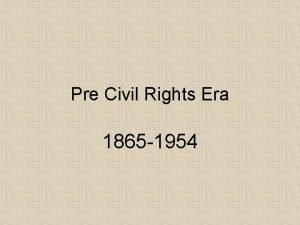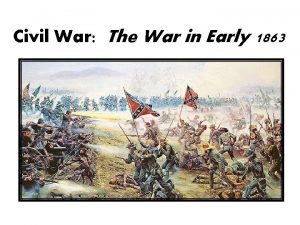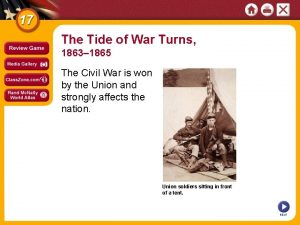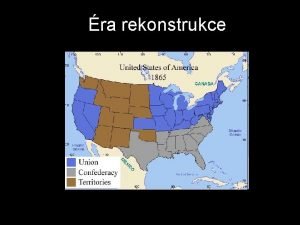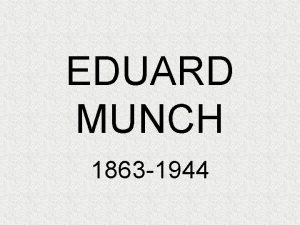THE CIVIL WAR 1863 1865 At first the




































- Slides: 36

THE CIVIL WAR 1863 - 1865

At first, the Civil War was not a war against slavery. It began as a war to preserve the Union, not to end slavery.

• President Lincoln had to handle the slavery issue cautiously – because four “slave states” remained in the Union. • He did not want to do anything that would cause these states to shift their loyalty to the Confederacy.

• President Lincoln, aware of the public’s growing support of abolishing slavery, decided to free enslaved African Americans living in the Confederate states. In the four slave states, however, slaves would not be freed. • Lincoln’s reasoning was to weaken the South without angering slave owners in the north.

• To avoid making his announcement appear as a last, desperate effort to save a losing cause, President Lincoln waited for a Union victory in battle to announce his plans. • The Battle of Antietam (September 17, 1862) gave him his chance!

“Preliminary” Emancipation Proclamation • President Abraham Lincoln • September 22, 1862 • ". . . on the first day of January. . . all persons held as slaves within any State, or designated part of a State, the people whereof shall then be in rebellion against the United States shall be then, thenceforward, and forever free. "

“Preliminary” Emancipation Proclamation • On January 1, 1863, anyone held as a slave in a state still in rebellion against the United States will be emancipated (freed). • Slaves in states that return to the Union prior to January 1, 1863, shall remain enslaved.

Emancipation Proclamation • President Lincoln issued the formal Emancipation Proclamation on January 1, 1863.

Emancipation Proclamation • Since the rebelling states were not under Union control, no slaves actually gained their freedom on January 1, 1863. • But, the Emancipation Proclamation changed the character of the war. Now, Union troops were fighting to end slavery as well as to preserve the Union. • The Proclamation also prompted a wave of support for the Union from “free” African Americans.

As the war dragged on, soldiers on each side came up with nicknames for the enemy. Union troops wore blue uniforms and were called “blues” or “Billy Yanks” – short for Yankees. Confederate troops wore gray uniforms and were called “grays” or “Johnny Rebs” – which was short for Rebels.

Soldiers on both sides were very young – most were between the ages 18 – 21.

New technology added to the horror of the Civil War battles: Cone-shaped bullets, which made rifles more accurate, replaced round musket balls. New cannons could hit targets up to several miles away.

As a result of these new, deadlier weapons more soldiers in battles became casualties (Killed or seriously wounded). Soldiers who were sick or wounded faced other horrors. Medical care on the battlefield was crude. Surgeons routinely cut off the injured arms and legs of wounded men.

Still, diseases such as pneumonia and malaria killed more soldiers than guns or cannons did!

• Not everyone in the North supported the war. • Some northerners thought the South should be allowed to secede from the Union. • Others were in favor of calling a peace conference to work out a compromise with the South. These people were called Copperheads.

• By 1863, there were not enough volunteers to fill the ranks of the Union army. Bounties, or payments, of $100. 00 had been given to men who enlisted to fight. • This was raised to $300. 00 – but still there were not enough volunteers.

Conscription Act • In March 1863, Congress passed an act that made all men between the ages 20 – 45 liable to be drafted for military service.

Conscription Act • Service could be avoided by paying the government $300. 00, or by paying someone to take your place. • This angered many people, especially the poor – who could not afford the $300.

Riots & Habeas Corpus • Some northerners felt they were being forced to fight to end slavery. Riots broke out in several cities (worst one was in New York City). • To prevent more riots, President Lincoln suspended habeas corpus - a person’s right to have a hearing before being jailed.

• The South had similar problems / results. Toward the end of the war, the South was unable to replace soldiers that were killed or wounded in battle. • There simply were not enough men to fill the ranks!

Financial Cost • In dollars and cents, the U. S. government estimated in 1863 that the war was costing $2. 5 million daily. A final official estimate in 1879 totaled $6, 190, 000. • The Confederacy spent perhaps $2, 099, 808, 707. • The civil war cost far more than any earlier war!

Financial Cost • Both sides needed to find ways to pay for it: – In the North, Congress passed the nation’s first income tax in 1861. It required all workers to pay a small part of their wages to the federal government. – The North also raised money by taxing goods, selling bonds, and raising prices of goods.

Financial Cost • The South had trouble raising money. – The Confederate Congress passed an income tax as well as a tax-in-kind. – The tax-in-kind required farmers to turn over 10% of their crops to the government. – The government would then sell the crops for profit.

• The Union blockade had hurt the South badly. – It created food / supply shortages for both soldiers and civilians (people who were not in the army. • Even when supplies were available, the South had trouble getting them to their troops. – As a tactic of war, Union armies ripped up railroad tracks, and the South had few parts to make repairs.

Women in the War • In both the North and the South, women took over jobs as men left home for the battlefield. • Women on both sides also volunteered to work as nurses. – Dorothea Dix – became superintendent (boss) of nurses for the Union army. – Clara Barton – earned fame as a nurse and founded the American Red Cross.

The Battle of Chancellorsville • Virginia – May 1863 – In this battle, General Robert E. Lee and General “Stonewall” Jackson again outwitted the Union army. Lee and Jackson defeated the Union in three days. – Although the South won the battle, it suffered a severe loss!

Battle of Chancellorsville • At dusk, Confederate guards fired shots at what they thought was a Union soldier riding toward them. • The “Union soldier”, it turned out, was “Stonewall” Jackson.

The Death of “Stonewall” Jackson • “Stonewall” Jackson died as a result of his injuries several days (8) later. • The plantation office building where “Stonewall” Jackson died.

The Vicksburg Campaign • General Ulysses S. Grant won several victories around Vicksburg, Mississippi. • On May 22, Grant began a siege of the city. • Six weeks later, Vicksburg fell under Union control, which placed the entire Mississippi River in Union hands.

The Gettysburg Campaign July 1 st, 2 nd, 3 rd, 1863 • General Robert E. Lee defeated Union forces in Virginia on June 13, 1863 and continued north to Pennsylvania. • On July 1 st a chance encounter between Union and Confederate forces began the Battle of Gettysburg. • In the fighting that followed, the Union had greater numbers and better defensive positions.

Cemetery Ridge • On July 2 nd, Confederate General James Longstreet urged General Lee to March south, which would force the Union army to come after them. This, he argued, would allow for a more favorable battlefield. • General Lee disagreed and ordered an attack he would later regret.

Pickett’s Charge • On July 3 rd, General Lee ordered 15, 000 men under General George Pickett to charge Cemetery Ridge. • In the charge, row after row of Confederates dropped to the ground. • In the end, Pickett’s charge failed – General Lee took the blame. • The Confederates would never again invade the north. The war had reached the turning point!!!

The Gettysburg Address • The Battle of Gettysburg left more than 40, 000 dead or wounded. On November 19, 1863, President Lincoln dedicated a portion of the Gettysburg battlefield as a national cemetery, and delivered his memorable Gettysburg Address.

Battle of Chickamauga (Tennessee / Georgia border) • On September 19, 1963, Union and Confederate forces battled near Chickamauga Creek. • Union forces retreated to Chattanooga, TN – the Confederacy maintained control of the battlefield.

Battle of Chattanooga (Tennessee / Georgia border) • On November 23 – 25, Union forces pushed Confederate forces away from Chattanooga, TN. • This victory set the stage for what would become Union General Sherman’s “march” through Georgia. General Ulysses S. Grant and General Braxton Bragg – the commanding generals of the Chattanooga Campaign.

Ulysses S. Grant • In 1864, President Lincoln appointed General Ulysses S. Grant as commander of the Union forces.
 Civil war first modern war
Civil war first modern war Chapter 16 lesson 2 challenges to slavery
Chapter 16 lesson 2 challenges to slavery July 1-4 1863
July 1-4 1863 The second industrial revolution timeline
The second industrial revolution timeline Manet, olympia, 1863
Manet, olympia, 1863 Impressionism 1867-1886
Impressionism 1867-1886 The stonebreakers
The stonebreakers Olympia gauguin
Olympia gauguin Edouard manet olympia 1863
Edouard manet olympia 1863 Edouard manet olympia 1863
Edouard manet olympia 1863 Olympia, 1863
Olympia, 1863 Constitucion de 1863
Constitucion de 1863 Hjälper sedan 1863
Hjälper sedan 1863 Nov 19 1863
Nov 19 1863 The three uses of money
The three uses of money Define soddies
Define soddies Civil rights and civil liberties webquest
Civil rights and civil liberties webquest Urban america 1865 to 1896
Urban america 1865 to 1896 St helen’s smelting co v tipping (1865)
St helen’s smelting co v tipping (1865) The rise of industrial america 1865-1900
The rise of industrial america 1865-1900 The rise of industrial america 1865-1900
The rise of industrial america 1865-1900 15 th ammendment
15 th ammendment Chapter 3 industrialization (1865 to 1901 answers)
Chapter 3 industrialization (1865 to 1901 answers) Becoming a world power 1865-1917
Becoming a world power 1865-1917 Traits of impressionism
Traits of impressionism Chapter 20 becoming a world power notes
Chapter 20 becoming a world power notes Guided reading activity settling the west 1865-1890 answers
Guided reading activity settling the west 1865-1890 answers Al cruzar una planta de guisantes de flores purpura
Al cruzar una planta de guisantes de flores purpura How did renoir glamorize his clientele?
How did renoir glamorize his clientele? 1877-1865
1877-1865 Realism and regionalism in american literature
Realism and regionalism in american literature Industrialization (1865 to 1901 worksheet answers key)
Industrialization (1865 to 1901 worksheet answers key) 1865 to 1900 inventions
1865 to 1900 inventions Causes of the civil war dbq
Causes of the civil war dbq Civil war map activity
Civil war map activity Sherman's neckties
Sherman's neckties Gtech gettysburg
Gtech gettysburg




